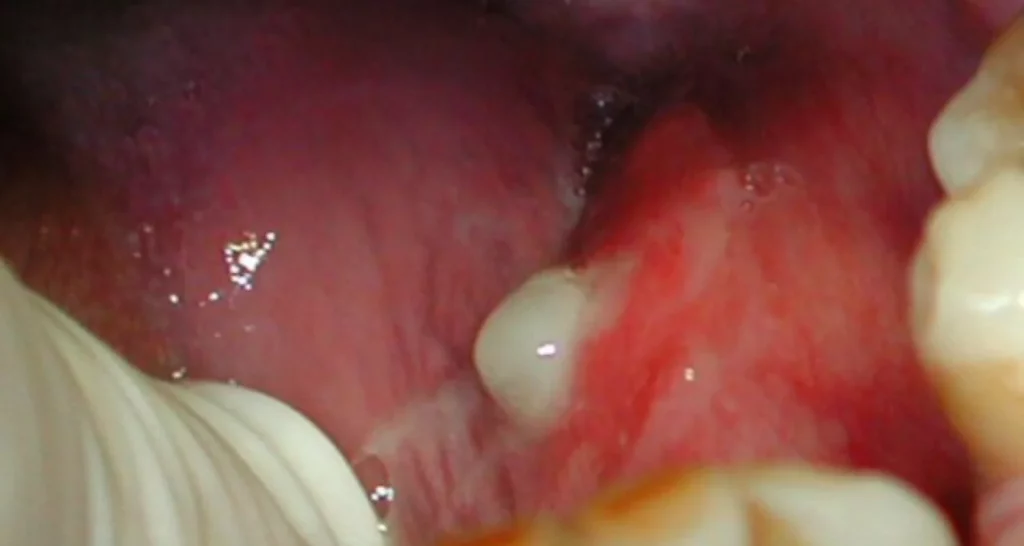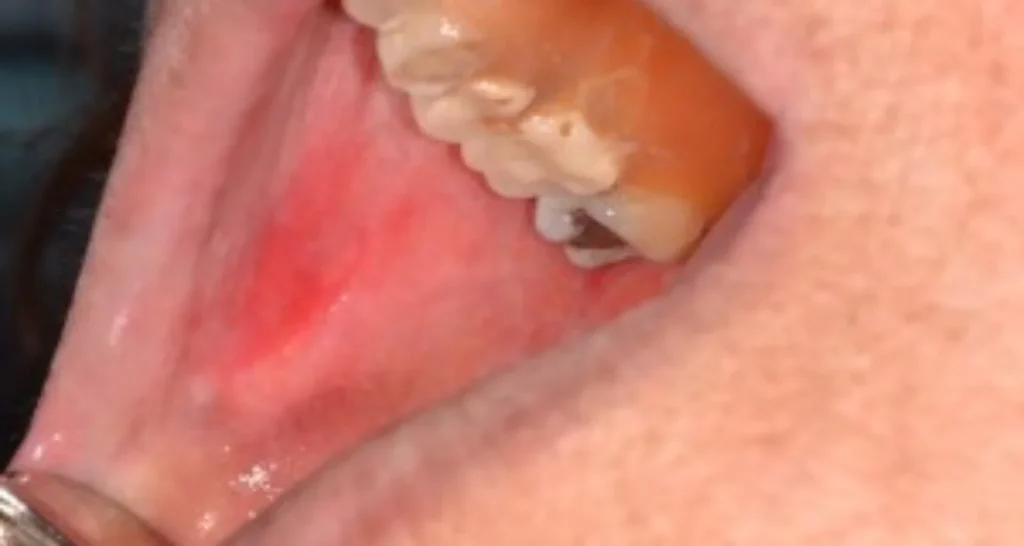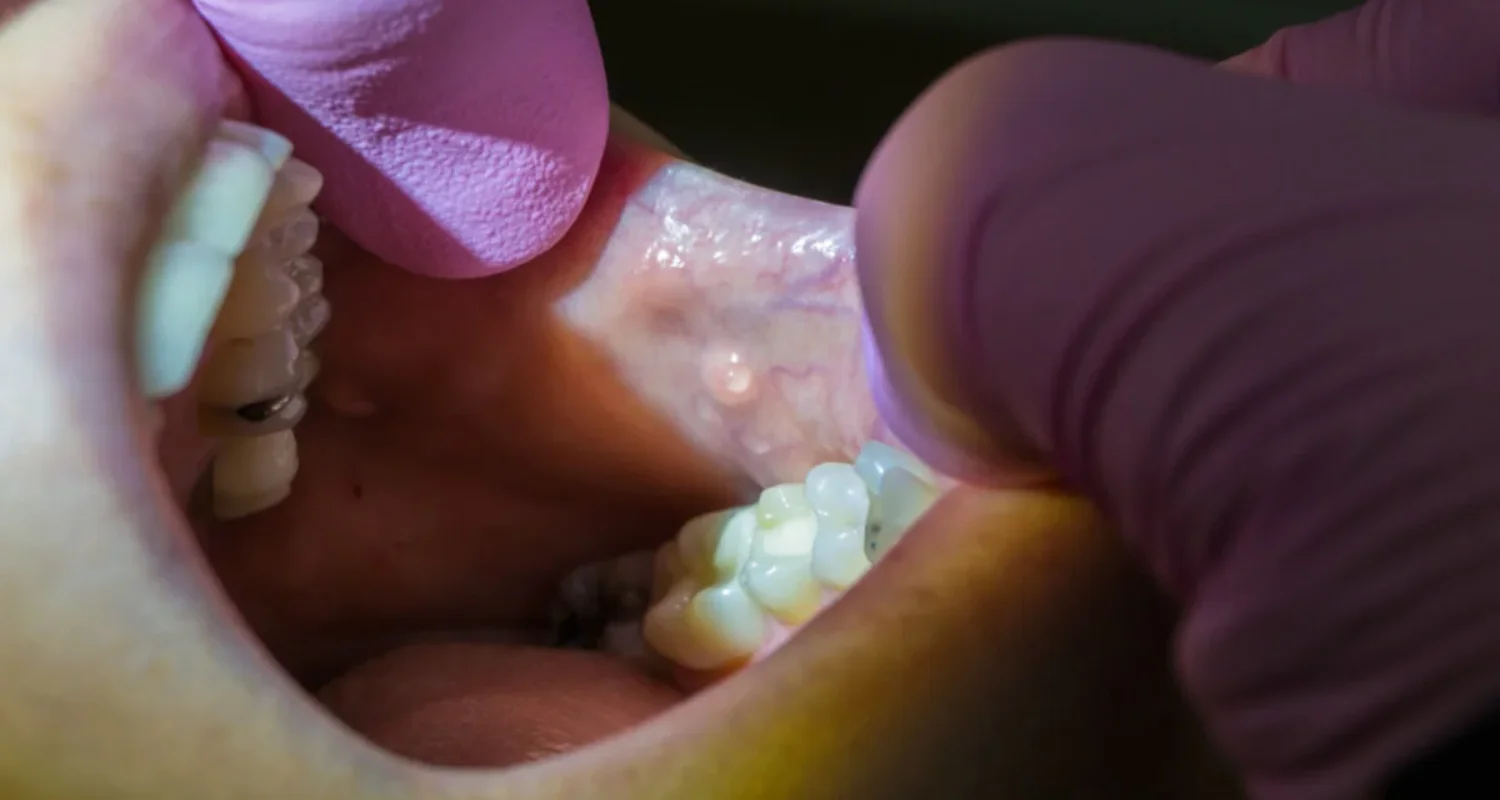Last Updated on: 13th June 2024, 08:54 am
✓ Fact Checked 🕓
❙ Our team of writers, editors, and medical experts rigorously evaluates each article to ensure the information is accurate and exclusively cites reputable sources.
❙ We regularly assess how the content in this article aligns with current scientific literature and expert recommendations in order to provide the most up-to-date research.
Unmasking Sialolithiasis: Salivary Gland Stones
Did you know that the most common cause of salivary gland inflammation is sialolithiasis? The formation of stones or stones in the salivary ducts, also called sialolithiasis, can obstruct the flow of saliva, causing swelling, pain, and infections. In this article, we tell you everything about stones in the salivary glands, their diagnosis, and treatment options.
What are Salivary Gland Stones?

Saliva is produced by structures called salivary glands, which are located in the cheek area, the oral mucosa, and the region under the tongue and jaw. Salivary gland stones or sialoliths are small stones formed by the accumulation of minerals such as calcium phosphate, magnesium, or carbonate, which block the saliva outlet ducts that connect the gland to the inside of the mouth.
They can occur singly or multiple times, being more common in the submandibular glands. Although they can occur at any age, in both men and women, they are more common in male patients between 30 and 70 years of age. This is generally not a serious condition, but it deserves attention.
What Causes Salivary Gland Stones?
The exact cause of stones forming in the salivary glands is not clear, but some conditions may contribute to their formation:
● Mineralization of foreign bodies or cells that come off the salivary gland or bacteria.
● Trauma to the salivary duct that hinders the flow of saliva, causing it to stagnate.
● High concentration of certain minerals in saliva.
● Decrease in salivary flow, generated by diseases, and consumption of medications or treatments such as radiotherapy.
Symptoms of Stones in the Salivary Glands: How to Recognize them

1. Pain, swelling, and decreased salivary flow:
Usually, stones in the salivary glands do not cause pain, but when they do occur, they range from mild discomfort to very intense pain, which usually increases before, during, and after eating food. When the passage of saliva through the salivary ducts is prevented, in addition to pain, swelling of the salivary gland and decreased salivary flow may occur. Scientific studies have shown that when stones cause symptoms, they are usually larger than 2 mm in diameter.
2. Unilateral swelling:
Although other conditions can cause inflammation of the salivary glands, when it occurs unilaterally, it is likely to entail salivary gland stones. However, although rare, sialoliths can also appear bilaterally.
Diagnosis of Stones in the Salivary Glands: Tests and Examinations
Depending on the location of the stone, its size, signs, and symptoms, a health professional may use various tests and examinations to diagnose the presence of stones in the salivary glands, including:
● Sialography
● Ultrasound
● Nuclear magnetic resonance
● Endoscopy
● X-rays
Treatment Options for Salivary Gland Stones: From Home Remedies to Surgery

Sometimes salivary stones pass on their own. It is also possible to eliminate them with some homemade tricks:
● Suck lemon or lemon drops.
● Drink lots of water.
● Consume sour candies, always performing adequate oral hygiene afterward.
● Gently massage around the stone.
Depending on the location, the gland involved, and the degree of mineralization of the stone, treatment options may be variable:
1. Drainage of the affected gland: When there is saliva buildup, it can cause swelling and pain. Draining the contents into the gland helps release pressure and eliminate pain.
2. Fragmentation with ultrasonic expansive waves: This procedure does not require anesthesia or sedation. Instead, weekly sessions are carried out until the stone is fragmented, facilitating removal. This last step is helped by medications or foods that increase saliva production, called sialogogues. They are indicated when stones that do not exceed 2 mm.
3. Antibiotics: They may be necessary when a deep blockage of the salivary glands has caused an infection. If required, they must be prescribed by a health professional.
4. CO2 laser: This type of laser cuts the stone, making it easier to remove.
5. Surgical treatment: Surgery is the classic alternative for large stones, where the stone is removed or in advanced cases, the entire salivary gland. This is indicated when results have not been obtained by removing only the sialolith. It is usually not the first choice of treatment, due to the risk of damaging nearby nerves, such as the one that controls facial movements (in the case of the parotid gland).
When to See a Doctor?
Consult a doctor in the following cases:
● If home remedies have failed to eliminate the stones.
● You have symptoms of infection, such as redness, pain, discharge of pus, or fever.
Remember that it is essential to eliminate salivary stones to avoid infections and abscesses, which in serious cases could spread to vital spaces, becoming a dangerous situation.
Prevention of Stones in the Salivary Glands: Suggestions and Advice

Because the cause of sialolithiasis is not entirely clear, preventing it completely can prove difficult. However, the following tips can help reduce the risk of stones appearing in the salivary glands:
● Avoid smoking
● Keep hydrated
● Try to have rigorous oral hygiene
● If you feel pain around the salivary ducts, perform massages to promote saliva flow.
Conclusion
● Salivary gland stones are not a serious condition, but when they cause salivary gland inflammation or sialadenitis, pain, and swelling can affect quality of life.
● Recognizing the early signs and seeking medical attention in case of complications is essential to timely treatment.
Frequently Asked Questions
Is the presence of stones in the salivary glands a serious problem?
When a stone blocks the duct through which saliva is secreted, an infection can arise in the gland, known as sialadenitis. During a check-up, the doctor can manually detect the presence of a stone in the salivary gland, or identify it through imaging methods such as computed tomography or ultrasound.
Blockage of the salivary ducts by stones can lead to complications if not treated properly. These solid formations, which prevent the normal flow of saliva, can trigger not only infections but also pain and swelling in the affected glands. Early diagnosis through advanced imaging techniques allows timely intervention, reducing the risk of complications and improving the prognosis for the patient.
Is it possible for salivary stones to be eliminated naturally?
In most cases, salivary gland stones can resolve without the need for advanced medical intervention, thanks to a conservative treatment approach. Increasing fluid intake, using localized heat applications or performing gentle massages on the affected area are methods that facilitate the expulsion of the stone from the salivary duct.
This self-resolution of salivary stones is based on stimulating the production and flow of saliva, thus helping to displace and finally expel the stone naturally. Such simple but effective practices represent a first line of action before considering more invasive treatment options, often allowing the avoidance of surgical procedures or more complex interventions.
Is using salt water effective to treat blockages in the salivary glands?
Rinsing your mouth with warm salt water, prepared by dissolving half a teaspoon or 3 grams of salt in a cup or 240 milliliters of water, can be an effective home remedy to mitigate pain and keep the mouth adequately hydrated. Furthermore, to promote the recovery process, it is advisable to stop smoking if you are a smoker. Increasing water intake and using sugar-free lemon candies are other measures that help stimulate saliva production, thus helping to reduce inflammation and promote the unclogging of the salivary glands.
These practices not only seek to relieve the symptoms associated with clogged salivary glands, but also aim to speed up the healing process. Salt water acts as a natural anti-inflammatory and antibacterial agent, while quitting smoking reduces irritation in the glands. Drinking plenty of water and stimulating salivation through lemon candies help maintain good oral hydration, a crucial aspect for the health of the salivary glands and the prevention of future blockages.
Is lemon water beneficial for the salivary glands?
Staying adequately hydrated is essential, consuming between 8 and 10 glasses of water daily. Adding lemon juice to water can act as a natural stimulant for saliva production. This increase in salivation facilitates the cleaning of the salivary glands, helping to eliminate stones or any type of accumulated residue.
Regular consumption of lemon water not only promotes healthy salivary flow, but also contributes to the prevention of new stone formation and the maintenance of oral health. This natural and simple method of salivary stimulation is an effective complement to salivary gland care strategies, offering a practical and refreshing way to support their optimal function.
Share:
References
1. Delgado, A. (Mar, 2019).Salivary duct stones. Healthline.https://www.healthline.com/health/salivary-duct-stones
2. Salivary gland disorders. (s/f). Mayo Clinic Health System. https://www.mayoclinichealthsystem.org/locations/mankato/services-and-treatments/otorhinolaryngology/throat-conditions-and-treatment/salivary-gland-disorders
3. Hammett, J. T., & Walker, C. (2023). Sialolithiasis. https://pubmed.ncbi.nlm.nih.gov/31751035/
4. Salivary gland stones. (Aug 14, 2023). Nhs.uk. https://www.nhs.uk/conditions/salivary-gland-stones/
5. Salivary gland stones. (Apr 22, 2022). WebMD. thehttps://www.webmd.com/oral-health/salivary-gland-stones-symptoms-causes-treatments
6. Salivary stones: Causes, symptoms & treatment. (Oct 26, 2022). Cleveland Clinic. https://my.clevelandclinic.org/health/diseases/24344-sialolithiasis
7. Sissons, B. (Feb 12, 2019). Salivary stones: Symptoms, causes, and how to get rid of them. Medicalnewstoday.com. https://www.medicalnewstoday.com/articles/324421
8. Kraaij, S., Karagozoglu, K. H., Forouzanfar, T., Veerman, E. C. I., & Brand, H. S. (2014). Salivary stones: symptoms, aetiology, biochemical composition and treatment. British Dental Journal, 217(11), E23–E23. https://doi.org/10.1038/sj.bdj.2014.1054














